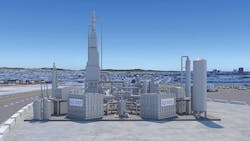U.S., Ukraine collaborating on pilot using Small Nuclear to generate Carbon-Free H2 and Ammonia
A consortium of energy researchers, government agencies and private industry developers from both the U.S. and Ukraine will work together on a pilot project to use small modular reactor nuclear power to create green hydrogen and ammonia.
The Ukraine Clean Fuels from SMRs pilot project will provide a demonstration of carbon-free power generation in that war torn, energy-strapped nation. The planned commercial-scale production of hydrogen and ammonia would be the first of its kind, planners say.
Hydrogen does not contain a carbon molecule and therefore does not emit carbon dioxide when combusted or used. Since it is not easily converted, H2 must be generated by one of several methods, including steam reforming of methane gas, which is carbon intensive.
The “green hydrogen” method is electrolysis powered by carbon-free energy resources such as nuclear, solar, wind or hydro. Electrolyzers use electricity to separate the H2 from water.
FuelCell Energy provides solid oxide electrolyzer technology and is part of the future collaboration. Fuel cells use an electrochemical process to convert fuels like hydrogen into electricity to provide carbon-free power for transportation and power generation, such as FuelCell Energy's 2.3-MW fuel cell project at the Port of Long Beach (pictured)
“The combination of small modular nuclear reactors and solid oxide electrolysis is a particularly good use case for both technologies - demonstrating ultra-high efficiency decentralized production of clean hydrogen. Unlocking the ability to co-locate the production of hydrogen with its use,” FuelCell Energy Chief Commercial Officer Mark Feasel said in a LinkedIn post about the U.S.-Ukraine collaboration.
See EnergyTech's full coverage of the Hydrogen role in the Path to Net Zero
Subscribe to our free, tri-weekly email newsletter for more stories about the C&I Energy Transition
Global Power Markets Outlook: The Energy Transition Gathers Pace
Download Research on key trends by Wood Mackenzie Power & Renewables
Special U.S. Presidential Envoy for Climate John Kerry and Ukraine Minister of Energy German Galushchenko announced the collaborative energy deal. Participants from the private and public sectors include the Argonne National Laboratory, Ukraine’s Energoatom, Clark Seed, Doosan Enerbility, FuelCell Energy, SMR designer NuScale Power, SamSung C&T and others.
“Building on existing capacity-building cooperation launched under the U.S. Foundational Infrastructure for Responsible Use of SMR Technology (FIRST) program, the project seeks to support Ukraine’s energy security goals, enable decarbonization of hard-to-abate energy sectors through clean hydrogen generation, and improve long-term food security through clean ammonia-produced fertilizers,” according to the release by the U.S. Department of State. “Further, it aims to demonstrate Ukraine’s innovative clean energy leadership through the use of advanced technologies.”
Ukraine’s power generation sector currently relies mainly on fossil fuels and nuclear power. The eastern European nation is currently locked into a war against Russia after the latter’s invasion in early 2022.
-- -- --
(Rod Walton, senior editor for EnergyTech, is a 14-year veteran of covering the energy industry both as a newspaper and trade journalist. He can be reached at [email protected]).
Follow us on Twitter @EnergyTechNews_ and @rodwaltonelp and on LinkedIn
About the Author
Rod Walton, EnergyTech Managing Editor
Managing Editor
For EnergyTech editorial inquiries, please contact Managing Editor Rod Walton at [email protected].
Rod Walton has spent 17 years covering the energy industry as a newspaper and trade journalist. He formerly was energy writer and business editor at the Tulsa World. Later, he spent six years covering the electricity power sector for Pennwell and Clarion Events. He joined Endeavor and EnergyTech in November 2021.
Walton earned his Bachelors degree in journalism from the University of Oklahoma. His career stops include the Moore American, Bartlesville Examiner-Enterprise, Wagoner Tribune and Tulsa World.
EnergyTech is focused on the mission critical and large-scale energy users and their sustainability and resiliency goals. These include the commercial and industrial sectors, as well as the military, universities, data centers and microgrids. The C&I sectors together account for close to 30 percent of greenhouse gas emissions in the U.S.
He was named Managing Editor for Microgrid Knowledge and EnergyTech starting July 1, 2023
Many large-scale energy users such as Fortune 500 companies, and mission-critical users such as military bases, universities, healthcare facilities, public safety and data centers, shifting their energy priorities to reach net-zero carbon goals within the coming decades. These include plans for renewable energy power purchase agreements, but also on-site resiliency projects such as microgrids, combined heat and power, rooftop solar, energy storage, digitalization and building efficiency upgrades.

